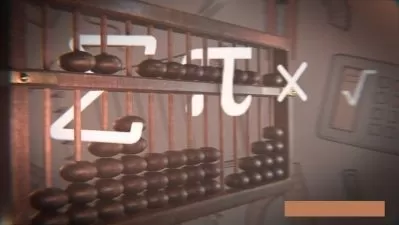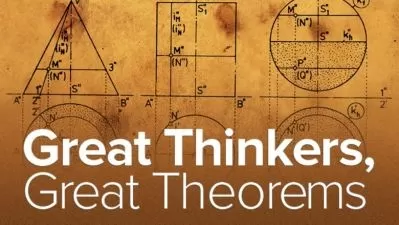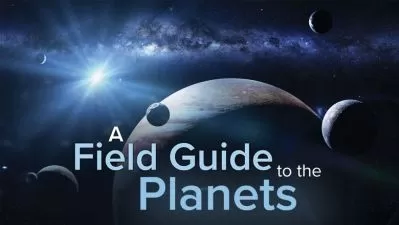Statistical Physics: relation to quanta and thermodynamics
Emanuele Pesaresi
7:52:07
Description
The mathematics used in the discovery of quantum physics, the foundations of thermodynamics, phase transitions.
What You'll Learn?
- Planck's mathematical trick which led to the discovery of quantum physics
- rigorous definition of entropy
- history of the physics of the 1900's
- Basics of Statistical Mechanics
- Einstein's papers on thermodynamics
- Brownian motion
- Lioville theorem
- Ideal gas law
- photoelectric effect
- canonical transformations
- Hamilton equations
- Black body problem
- Phase transitions
Who is this for?
What You Need to Know?
More details
DescriptionFirst part of the course:
The first part of the course showcases the beautiful mathematics that, in the late 19th century/ early 20th century, led to the discovery of a revolutionary branch in physics: Quantum Mechanics.
Planck postulated that the energy of oscillators in a black body is quantized. This postulate was introduced by Max Planck in his derivation of his law of black body radiation in 1900. This assumption allowed Planck to derive a formula for the entire spectrum of the radiation emitted by a black body (we will also derive this spectrum in this course). Planck was unable to justify this assumption based on classical physics; he considered quantization as being purely a mathematical trick, rather than (as is now known) a fundamental change in the understanding of the world.
In 1905, Albert Einstein adapted the Planck postulate to explain the photoelectric effect, but Einstein proposed that the energy of photons themselves was quantized (with photon energy given by the Planck–Einstein relation), and that quantization was not merely a "mathematical trick". Planck's postulate was further applied to understanding the Compton effect, and was applied by Niels Bohr to explain the emission spectrum of the hydrogen atom and derive the correct value of the Rydberg constant.
In addition to the very useful mathematical tools that will be presented and discussed thoroughly, the students have the opportunity to learn about the historical aspects of how Planck tackled the blackbody problem.
Calculus and multivariable Calculus are a prerequisite to the course; other important mathematical tools (such as: Fourier Series, Perseval's theorem, binomial coefficients, etc.) will be recalled, with emphasis being put on mathematical and physical insights rather than abstract rigor.
Second part of the course
By the end of June 1902, just after being accepted as Technical Assistant at the Federal Patent Office in Bern, Albert Einstein, 23, sent to the renowned journal Annalen der Physik a manuscript with the bold title “Kinetic Theory of Thermal Equilibrium and of the Second Law of Thermodynamicsâ€. In the introduction, he explains that he wishes to fill a gap in the foundations of the general theory of heat, “for one has not yet succeeded in deriving the laws of thermal equilibrium and the second law of thermodynamics using only the equations of mechanics and the probability calculusâ€. He also announces “an extension of the second law that is of importance for the application of thermodynamicsâ€. Finally, he will provide “the mathematical expression of the entropy from the standpoint of mechanicsâ€.
In particular, in the second part of the course we will see the mathematics Einstein used in his paper from 1902.
Besides, other concepts from Classical mechanics are explained, such as Liouville's theorem (this theorem is used by Einstein in his article), as well as Hamilton equations and more.
For the second part, the student should already be familiar with phase space and other concepts from classical physics (such as Lagrange equations).
Third part of the course
In the third part of the course some of the articles of Einstein's Annus Mirabilis are explained. In particular, the article on the photoelectric effect and that on the Brownian motion.
Fourth part of the course
In the last section of this course we focus on the derivation of phase transitons from the Ising model. All the previous sections will be useful in contextualizing this last part of the course.
Who this course is for:
- physics students
- mathematics students
- anyone interested in the historical fascinating origin of Quantum Physics
- anyone interested in the mathematics used by Einstein in 1902 dealing with thermodynamics
- anyone who seeks an in-depth understanding of entropy
- Students who would like to improve their reasoning and insights in solving physical problems
- anyone interested in explanations given through the lens of mathematics
- engineering students
First part of the course:
The first part of the course showcases the beautiful mathematics that, in the late 19th century/ early 20th century, led to the discovery of a revolutionary branch in physics: Quantum Mechanics.
Planck postulated that the energy of oscillators in a black body is quantized. This postulate was introduced by Max Planck in his derivation of his law of black body radiation in 1900. This assumption allowed Planck to derive a formula for the entire spectrum of the radiation emitted by a black body (we will also derive this spectrum in this course). Planck was unable to justify this assumption based on classical physics; he considered quantization as being purely a mathematical trick, rather than (as is now known) a fundamental change in the understanding of the world.
In 1905, Albert Einstein adapted the Planck postulate to explain the photoelectric effect, but Einstein proposed that the energy of photons themselves was quantized (with photon energy given by the Planck–Einstein relation), and that quantization was not merely a "mathematical trick". Planck's postulate was further applied to understanding the Compton effect, and was applied by Niels Bohr to explain the emission spectrum of the hydrogen atom and derive the correct value of the Rydberg constant.
In addition to the very useful mathematical tools that will be presented and discussed thoroughly, the students have the opportunity to learn about the historical aspects of how Planck tackled the blackbody problem.
Calculus and multivariable Calculus are a prerequisite to the course; other important mathematical tools (such as: Fourier Series, Perseval's theorem, binomial coefficients, etc.) will be recalled, with emphasis being put on mathematical and physical insights rather than abstract rigor.
Second part of the course
By the end of June 1902, just after being accepted as Technical Assistant at the Federal Patent Office in Bern, Albert Einstein, 23, sent to the renowned journal Annalen der Physik a manuscript with the bold title “Kinetic Theory of Thermal Equilibrium and of the Second Law of Thermodynamicsâ€. In the introduction, he explains that he wishes to fill a gap in the foundations of the general theory of heat, “for one has not yet succeeded in deriving the laws of thermal equilibrium and the second law of thermodynamics using only the equations of mechanics and the probability calculusâ€. He also announces “an extension of the second law that is of importance for the application of thermodynamicsâ€. Finally, he will provide “the mathematical expression of the entropy from the standpoint of mechanicsâ€.
In particular, in the second part of the course we will see the mathematics Einstein used in his paper from 1902.
Besides, other concepts from Classical mechanics are explained, such as Liouville's theorem (this theorem is used by Einstein in his article), as well as Hamilton equations and more.
For the second part, the student should already be familiar with phase space and other concepts from classical physics (such as Lagrange equations).
Third part of the course
In the third part of the course some of the articles of Einstein's Annus Mirabilis are explained. In particular, the article on the photoelectric effect and that on the Brownian motion.
Fourth part of the course
In the last section of this course we focus on the derivation of phase transitons from the Ising model. All the previous sections will be useful in contextualizing this last part of the course.
Who this course is for:
- physics students
- mathematics students
- anyone interested in the historical fascinating origin of Quantum Physics
- anyone interested in the mathematics used by Einstein in 1902 dealing with thermodynamics
- anyone who seeks an in-depth understanding of entropy
- Students who would like to improve their reasoning and insights in solving physical problems
- anyone interested in explanations given through the lens of mathematics
- engineering students
User Reviews
Rating
Emanuele Pesaresi
Instructor's Courses
Udemy
View courses Udemy- language english
- Training sessions 56
- duration 7:52:07
- Release Date 2024/03/10
















